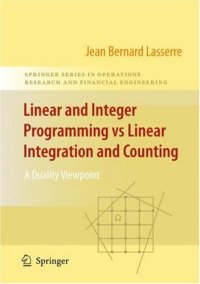
Ebook: Linear and integer programming vs linear integration and counting: A duality viewpoint
Author: Jean-Bernard Lasserre (auth.)
- Genre: Computers // Programming
- Tags: Convex and Discrete Geometry, Discrete Mathematics in Computer Science, Optimization, Operations Research Mathematical Programming
- Series: Springer Series in Operations Research and Financial Engineering
- Year: 2009
- Publisher: Springer-Verlag New York
- Edition: 1
- Language: English
- pdf
In this book the author analyzes and compares four closely related problems, namely linear programming, integer programming, linear integration, linear summation (or counting). The focus is on duality and the approach is rather novel as it puts integer programming in perspective with three associated problems, and permits one to define discrete analogues of well-known continuous duality concepts, and the rationale behind them. Also, the approach highlights the difference between the discrete and continuous cases. Central in the analysis are the continuous and discrete Brion and Vergne's formulae for linear integration and counting. This approach provides some new insights on duality concepts for integer programs, and also permits to retrieve and shed new light on some well-known results. For instance, Gomory relaxations and the abstract superadditive dual of integer programs are re-interpreted in this algebraic approach.
This book will serve graduate students and researchers in applied mathematics, optimization, operations research and computer science. Due to the substantial practical importance of some presented problems, researchers in other areas will also find this book useful.
This book analyzes and compares four closely related problems, namely linear programming, integer programming, linear integration, and linear summation (or counting). The focus is on duality and the novel approach puts integer programming in perspective with three associated problems, and permits one to define discrete analogues of well-known continuous duality concepts, and the rationale behind them. Also, the approach highlights the difference between the discrete and continuous cases. Central in the analysis are the continuous and discrete Brion and Vergne’s formulae for linear integration and counting which are not very well-known in the optimization community. This approach provides some new insights on duality concepts for integer programs, and also permits to retrieve and shed new light on some well-known results. For instance, Gomory relaxations and the abstract superadditive dual of integer programs are re-interpreted in this algebraic approach.
This book will serve graduate students and researchers in applied mathematics, optimization, operations research and computer science. Due to the substantial practical importance of some presented problems, researchers in other areas will also find this book useful.